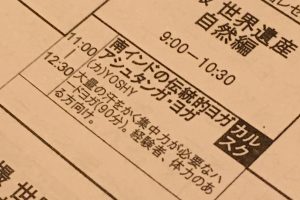遅れましたが今月のテーマです。
もう何年も前に多くの方がアシュタンガヨガの練習で、「どのポーズまで行った?」
という会話をしているときにスタンディング(立位)のポーズで『ムーラ・ダーラチャクラ』
を意識しながら練習していました。
このことを話しても、『あ、そう。。。。』と言われるだけでしたが・・・
何はともあれ、今月のヴィンヤサクラスのテーマをお読みくだされ。
東京のあっきーの訳です~
Standing Asanas
立位のアサナ
Standing asanas-also referred to as standing poses or standing seats-are the building blocks of a yoga asana practice. They represent our ability to be grounded, to stand on our own feet. This is essential to the attainment of Yoga-enlightenment, eternal happiness, realization of the Oneness of being. The path to enlightenment can be long, and it requires intense dedication and persistence. Through the practice of standing poses, the body becomes strong and articulate and the mind alert and focused, which is very helpful for a practice aimed at making the practitioner more conscious.
立位のアーサナ(立位のポーズあるいは立った状態の坐位と呼ばれるもの)は、
ヨガのアーサナの練習において下からブロックを1つ1つ積み上げているようなものです。
それらは私たちが大地と繋がる能力、自らの足で立つ能力を表しているともいえるでしょう。
その能力は、ヨガによる悟り、永遠の幸福、そしてあらゆる存在と一体であると感じることのために不可欠です。
悟りへ至る道は長くなりがちで、かつ真剣な集中と持続を必要とします。
立位のポーズの練習により、身体は鍛えられて動きがかみ合うようになり、
ココロは気づきに満ちて集中するようになります。
それはヨガの練習者の意識を高めることに役に立つのです。
Standing asanas provide an opportunity to resolve past karmas, especially karmas associated with the first chakra-muladhara, or root, chakra-located at the pelvic floor. Muladhara chakra corresponds to our relationships to the earth, our parents, family, home, authority figures, career, money, environment and issues of survival. When we practice standing asanas, we are often confronted with pain, stiffness, discomfort, fears or anxieties relating to these people and issues in our lives, and by noting the sensations and emotions without judging, denying or running away from them, we set ourselves free from the bonds of those karmas and purify the root chakra.
立位のアーサナは過去のカルマ、特に、骨盤(胴体)の一番下にある一番目のチャクラ-ムーラダラ・チャクラあるいは根源のチャクラと呼ばれる-と関連して蓄積されたカルマを浄化する機会をもたらします。
ムーラダラ・チャクラは私たちが持つつながり、地球(大地)との、両親との、家族との、わが家との、上司との、職業との、お金との、環境との、そして生き延びるための問題とのつながりに対応しています。
立位のアーサナを練習していると、私たちはよく痛みや身体のかたさや、不快な感じ、つながりのある人々と人生の問題に関係する恐れや心配事に直面します。
そして、それらの感情や感覚を良い悪いの判断なしで注意深く観察することや、拒否したり逃げたりしないことで、過去のカルマの縛りから自由になって根源のチャクラを浄化することができるのです。
Standing asanas are important for their complete practice-they include forward and backward bending, twisting, inversion, and balancing. Each standing pose shares a common pattern of energy flow: energy moves up the front of the body and down the back of the body. This energetic flow is reflected in (and affected by) the alignment of the bones. With practice, the habitual disconnection between body and mind begins to decrease. As awareness of the energy flow increases, the movements of the physical body become clearer-more efficient-due to the greater connection with the intent of the mind.
立位のアーサナの数々は(カルマからの解放を目指す)完全な練習にとって大切です。
それらは前屈と後屈、ねじり、逆転、バランスのアサナを含みます。
それぞれの立位のアサナは共通したエネルギーの流れを持っています。
エネルギーは身体の前側を上昇し、後ろ側を下降します。
このエネルギーの流れは骨格の並び(整列)に影響を与え、また影響を受けています。
ヨガの練習により、もはやくせになっている心と体の分離は消え始めるのです。
エネルギーの流れへの意識が増すにつれ、物理的な身体の動きはより明確になり、
より効果的になり、自分の意志とのより強いつながりをもたらすでしょう。
The most fundamental standing asana is tadasana-mountain seat. It is also called samasthiti, which means “same steadiness,” or “equal standing.” The alignment we strive to perfect in tadasana is reflected throughout every other asana in our practice. If we can master tadasana, then all of the other asanas are like building blocks on a strong foundation. Conversely, without a solid connection to the earth, anything that we build up from that insecure foundation will be unstable. Tadasana begins with the feet-the physical connection to the earth. The feet should be together pressing down into the ground, with equal weight on the outer and inner balls of the feet and outer and inner heels. As the feet press down, all three arches of the feet should lift up-front to back on the inner and outer sides and from the big toe joint to the little toe joint. The arches create a mula bandha effect, directing energy received from the good connection of the four support points on the foot upward.
最も基礎的な立位のアーサナはタダーサナ-山のポーズです。
それはまたサマスティッティ-”変わらぬ安定”あるいは”均等な立ち方”を意味する-とも呼ばれます。
私たちがタダーサナで努力する正しい姿勢は、ほかの全てのアサナに反映されるものです。
私たちがタダーサナを習得したなら、ほかの全てのアサナは強固な積み上げ部品(基礎的な要素)となります。
逆に言えば、大地との強固なつながりがない状態で、
不安定な基礎上に何を作り上げても安定するはずがないのです。
タダーサナは両足-大地の物理的なつながり-から整えていきます。
両足は等しく大地に押しつけられ、しかも親指の付け根と小指の付け根、
かかとの外側と内側の四カ所に等しく体重が乗っています。
両足が押しつけられると、足の三つのアーチが持ち上がります。
それは足の前側から後ろ側にかけての内側と外側、そして親指付け根から小指付け根の三つです。
3つのアーチは、足の四つの支点と大地との優れたつながりから上昇して、
受け止められるエネルギーを導くムラ・バンダの効果を創り出します。
Another key to proper alignment relates to the limbs. Through a combination of external and internal rotation, subtle spirals are formed in the legs and arms that create stability and conduct energy upwards. The thighs and upper arms rotate outward, while the shins and forearms rotate inward. These rotations are both physical and energetic, and they mimic the double helix shape of our DNA, as well as the spiraling of ida and pingala nadis (left and right energy channels) around sushumna nadi (the central energy channel). These spirals should be formed in the limbs not only in tadasana, but in all other asanas as well.
もうひとつの正しい姿勢への鍵は手足に関わっています。
手足の外旋と内旋の組み合わせによって、安定性をもたらし、
エネルギーを上向かせる内的で精妙な螺旋(らせん)的動きは手足に形づくられます。
大腿部と上腕部は外旋(訳注:この場合、正面から身体を見たときに、頭頂部から真っ直ぐ下へ向かう中心線から離れる方向へ回すこと。)し、すねと前腕部は内旋(訳注:外旋と逆に中心線へ近づく方向へ回す)します。
これら外旋と内旋は物理的でもあり、エネルギーの流れのことでもあります。そして外旋と内旋は遺伝子の二重らせんと、同様にスシュムナナディ(身体の中心を通るエネルギーの通り道)の周囲にあるイダナディとピンガラナディ(左右のエネルギーの通り道)の螺旋(らせん)を模倣しているのです。
これらの螺旋状態はタダーサナだけではなく、
ほかの全てのアーサナでも手足に形づくられていなければなりません。
Here are just a few of the other alignment points in tadasana:
タダーサナの他の注意点を挙げます。
Quadriceps contract, kneecaps lift
大腿四頭筋を収縮(訳注:太ももの前の筋肉に力を入れる)させて、膝のお皿を持ち上げる。
Tailbone and pubic bone move toward each other
尾骨と恥骨をお互いに近づける。
Lower abdomen lifts up and in
下腹部を引き込んで持ち上げる。
Sternum lifts, collarbones spread apart, front ribs soften toward waist, back ribs expand
胸骨を持ち上げ、鎖骨を左右に引き離し、前側のあばら骨を腰へゆったりと下げ、後ろ側のあばら骨を広げる。
Chin parallel to floor
あごは床と平行にする。
Shoulder blades move down the back
肩胛骨は下げ、左右を寄せるようにする。
Arms extend, palms face thighs, fingers reach toward the floor
腕は伸ばし、手のひらは大腿へ向ける。指は床へ伸ばす。
Eyes soft, gaze neutral toward the horizon
目の力を抜き、地平線を見つめるようにする。
In tadasana, we embody aspects of the mountain: strong, steady, resolute, eternal, unwavering, dignified. The posture reflects how we should stand in the world-balanced on two feet, with a steady and happy connection to the earth and all beings. And when you find tadasana in every standing pose and, in fact, in every other asana you practice, you will find a connection to the earth, which will direct you to the Divine.
タダーサナで私たちは山のありようである、力強さ、不動、不屈、永遠、不惑、威厳を表現しています。
タダーサナは私たちがどれほど、二つの足で世界と調和のとれた立場にいて、安定して、幸せなつながりを大地とすべての存在との間に持っているかを反映しています。
そしてあなたがタダーサナを全ての立位のポーズに見出す時、そして実際に、あなたが練習している全ての他のポーズにも見出す時、
あなたは私たちを聖なるものへと導くであろう大地とのつながりを見出すことでしょう。
-Sharon Gannon




コメントを残す